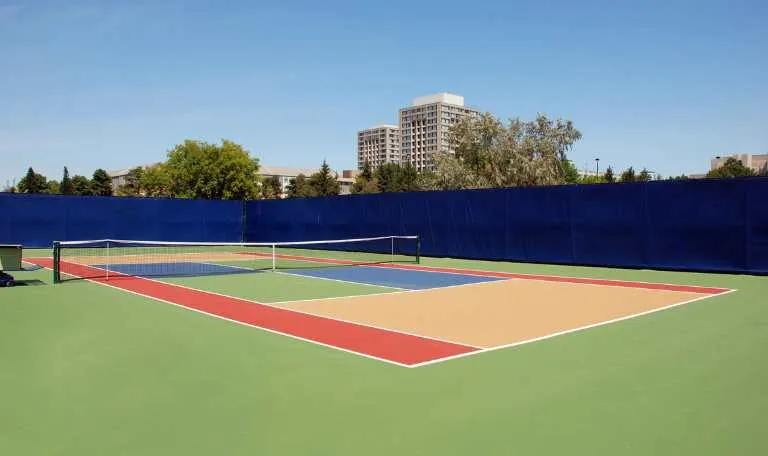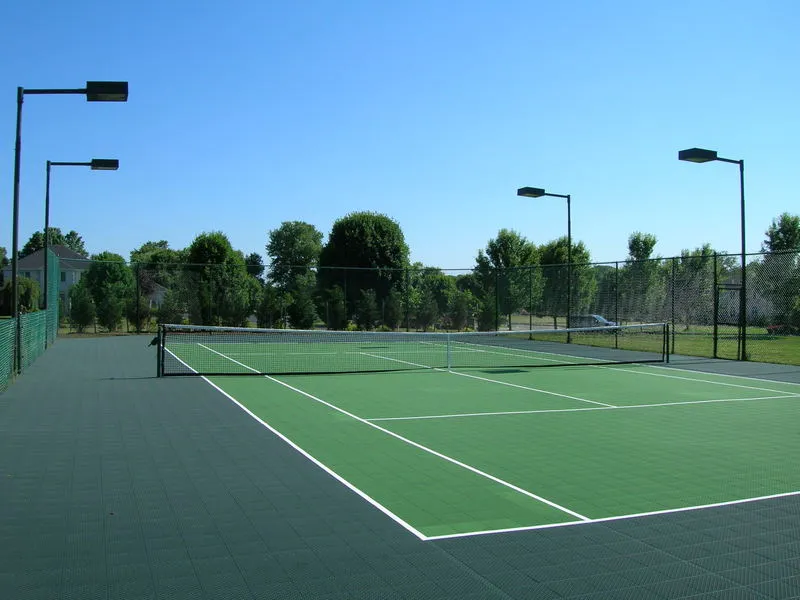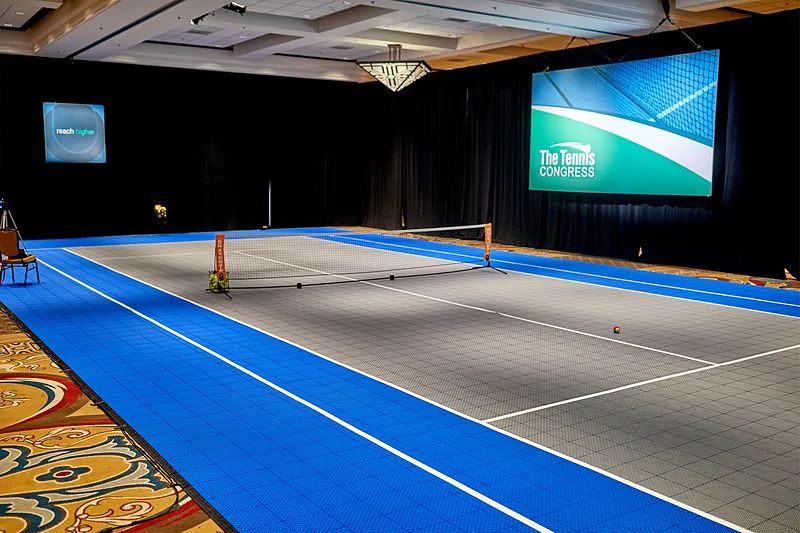Home » Tennis Court » Guide to Tennis Court Construction & Resurfacing In Texas

“In Texas, everything is bigger, including our ambitions.” Building a tennis court here means meeting the high standards of a state known for doing things on a grand scale. Texas boasts a vibrant tennis community, with countless players enjoying the sport year-round. Tennis courts serve as vital hubs for community building, fostering friendships, and promoting healthy living.
Whether you’re an enthusiast in Dallas/Fort Worth, part of a club in Austin or Houston, or managing facilities for schools and parks across the state, quality tennis courts are essential for both competitive and recreational play. With such strong demand, understanding the process of construction and resurfacing is crucial.
This comprehensive guide will explore the key aspects of tennis court construction and resurfacing in Texas, ensuring your facility remains top-notch and ready for action.
Planning to surface a tennis court in the near future? Get an instant cost estimate for your project by using our tennis court cost calculator.
Cost Considerations for Texas Tennis Court Construction and Resurfacing
The cost of tennis court construction and resurfacing in Texas depends on various factors, including the size of the court, surface material, and any additional features such as lighting or fencing.
On average, a new tennis court construction can range from $20,000 to $140,000, while resurfacing Texas tennis court projects typically cost between $5,000 and $10,000.
The number of courts and other factors can significantly impact the overall cost, making it essential to discuss your specific needs with your chosen contractor.
When budgeting for your project, consider your needs and any desired add-ons. Resurfacing a tennis court in Texas might be the perfect opportunity to add some much-needed amenities like new LED lighting, facilities for players and spectators, and improved drainage systems.
Work with your chosen contractor to develop a detailed cost estimate and explore potential cost-saving measures.
Use our tennis court cost calculator to get a tailored cost estimate for your project.
Texas vs. the rest of the country
The cost of constructing or resurfacing a tennis court in Texas generally falls on the low to mid-range of the spectrum compared to other U.S. states. This affordability is largely influenced by Texas’s relatively lower cost of living, competitive labor wages, and the price of construction materials. Additionally, Texas’s regulatory environment, which is less stringent than in some states, may further reduce overall costs associated with tennis court construction and resurfacing.
Read more:

Texas' Climate and Its Effect on Tennis Court Construction
Texas’ varied climate greatly influences the development and maintenance of tennis courts, with distinct variations across regions such as East Texas, West Texas, Central Texas, and the Gulf Coast area.
East Texas vs. West Texas:
- East Texas: This area experiences higher humidity and rainfall, especially in spring and fall. Tennis courts here require materials and surfaces that can handle moisture and fluctuating temperatures. Adequate drainage systems are essential to prevent water accumulation and damage from freeze-thaw cycles.
- West Texas: Known for its arid conditions, courts in this region must withstand high temperatures and intense sun exposure. It’s important to select materials that resist degradation under UV rays and maintain their playability in hotter conditions.
Central Texas vs. Gulf Coast:
- Central Texas: Experiencing a mix of humid and dry conditions with bouts of extreme heat in the summer, tennis court materials here need to be durable enough to cope with sudden weather shifts and extreme heat without cracking.
- Gulf Coast: Higher humidity and the presence of salt in the air can deteriorate court surfaces and materials. It’s crucial to use materials that are resistant to moisture and salt corrosion.
Sun Exposure and Heat
Particularly in southern and western Texas, the severe sun and high temperatures can degrade court surfaces. Courts should incorporate UV-resistant materials and, potentially, reflective coatings to reduce heat absorption and prevent surface damage.
Wind Patterns
Areas like the Panhandle and Gulf Coast frequently encounter significant winds. Court features such as fences and lighting must be designed to withstand these conditions, ensuring stability and wind resistance.
Soil and Land Conditions
Texas features a range of soil types, including expansive clay soils in parts of North Texas. Courts must be built on well-prepared foundations to prevent surface shifting and cracking.
Drought and Water Conservation
Frequent droughts in Texas necessitate water-conserving strategies, especially in landscape and drainage design, to adapt to local water use restrictions.
Understanding these climatic and environmental factors is crucial for anyone planning to build or resurface tennis courts in Texas, ensuring the development of durable and sustainable sports facilities.

Choosing Your Tennis Court Construction Company in Texas
Choosing the right tennis court builder in Texas goes beyond simple selections; it’s about forming a strategic partnership. When evaluating potential builders, consider several key aspects:
- Budget and Scalability: Does the builder provide solutions that align with your financial constraints and can be adjusted based on project scope?
- Timeline: Is the builder capable of completing the project within your specified timeframe?
- Customization: How adaptable is the builder with adding custom features such as specialized lighting and fencing?
- Ongoing Maintenance: Given Texas’s varied climate, regular maintenance is crucial to preserve the court’s condition.
- Warranty: What guarantees does the builder offer to protect your investment?
Questions for Tennis Court Construction Companies in Texas:
- Do you have experience with Texas-specific building regulations?
- Can you provide examples of past projects in Texas?
- What is your typical timeline for completing a project?
- Do you offer ongoing maintenance services?
- What certifications and industry memberships do you hold?
- Is your company fully licensed and insured in Texas?
Top Tennis Court Construction Companies in Texas
VersaCourt
VersaCourt stands as a premier provider of top-tier tennis courts, distinguished by its cutting-edge modular interlocking tiles that offer exceptional durability and high performance. Their advanced tile system creates safe, versatile surfaces that can be customized for a wide range of settings, from residential backyards to professional sports arenas. VersaCourt also provides full-service design and installation across Texas, working closely with clients to develop courts that meet their specific aesthetic and functional needs. Their products are widely installed in schools, parks, and resorts, enhancing both safety and visual appeal. VersaCourt’s dedication to quality is evidenced by their ISO 9001:2008 certification.
Tennis Court Systems:
VersaCourt’s tennis court systems offer a range of key benefits:
- Consistent Ball Bounce: Precision-engineered for dependable play.
- Enhanced Safety: Designed to reduce the risk of injury with excellent traction.
- Easy Maintenance: The modular tile design makes cleaning and repairs simple.
- Customizable Design: Flexible to meet the unique requirements of both residential and professional environments.
- Durability: Built to withstand a variety of conditions, ensuring long-lasting performance.
- Versatile Installation: Available with professional installation services or DIY options for greater convenience.
Services Offered:
- Custom design and installation of courts.
- DIY installation support for customers.
- Integration with features from The Recreational Group, such as synthetic turf and playground surfaces.
Certifications & Memberships:
- ISO 9001:2008 certification, showcasing a strong commitment to quality management.
Outdoor Tennis Court Installation by VersaCourt

Indoor Tennis Court Installation by VersaCourt

California Sports Surfaces
Founded in 1953, California Sports Surfaces (CSS) is a world-renowned leader in sports surface technology, celebrated for its innovative surfaces that boost athletic performance. As a proud member of the American Sports Builders Association (ASBA) and certified across four ITF Court Pace categories, CSS has established a strong presence in the U.S., particularly in Texas. Their impressive portfolio includes high-profile events like the Olympics and the US Open, and their expertise has been recognized in five of the ASBA 2023 Outstanding Facilities of the Year.
Tennis Court Systems
- DecoTurf®: The official surface of the US Open from 1978 to 2019, this low-maintenance option is versatile enough for all levels of play, with recognized ITF pace ratings.
- Plexipave: Renowned for its top-tier sports surfaces, Plexipave has been the surface of choice for events like the Australian Open (2008-2019) and the BNP Paribas Open.
- Rebound Ace®: Internationally acclaimed for its cushioned, multi-layered surfaces, ideal for a variety of sports including netball and basketball.
- Premier Sports Coatings®: Provides high-performance coatings suitable for residential courts, clubs, universities, and other recreational facilities.
Certifications & Memberships
- Member of the American Sports Builders Association (ASBA)
- ITF Court Pace Certification in categories 1-4
Featured project by California Sports Surfaces at the Delray Beach Open Tennis Center.
Ecore Athletic
Ecore Athletic specializes in tennis court surfacing that enhances player performance through the use of durable, ergonomic, and acoustically optimized materials. Designed for both indoor and outdoor courts, their surfaces prioritize safety, comfort, and top-tier performance. With a strong commitment to sustainability, Ecore Athletic focuses on reducing rubber waste and creating environmentally responsible products. Operating throughout Texas, they deliver high-quality solutions tailored to the state’s diverse tennis environments.
Tennis Court System
- TrueCourt System: Specifically designed for outdoor tennis courts, TrueCourt offers exceptional durability and optimal shock absorption, making it ideal for external environments.
- TeamPlay M System: Tailored for indoor tennis courts, this system provides consistent ball response and enhanced cushioning, ensuring player safety and comfort in indoor settings. Both systems are engineered with sustainability in mind and meet the rigorous demands of modern tennis.
Services Offered
- Nationwide design and installation services for tennis courts.
- Customized solutions to meet specific project requirements.
Certifications & Memberships
- Member of the American Sports Builders Association (ASBA)
- Certified with FloorScore®, EPDs, HPDs, GREENGUARD Gold, and ISO 9001.
Understanding Texas Regulations and Permits for Tennis Court Construction
Before breaking ground on your tennis court project, it’s essential to understand the regulations and permits required in Texas.
These requirements vary by county and city, so working with a well-versed contractor in local regulations is crucial. Some key factors to consider include:
- Zoning laws and land use regulations
- Stormwater drainage requirements
- Environmental impact studies
- Building codes for lighting, fencing, and other structures on the court
Most tennis court construction and resurfacing Texas projects require specific permits, such as building permits, electrical permits (for lighting), and drainage permits.
Your chosen contractor should guide you through the process and ensure all necessary permits are obtained before work begins.
Check out our city-level guides on tennis court development in Texas for more information about local permits and regulations.

Suitable Tennis Court Surfaces for Texas
When it comes to tennis court construction and resurfacing in Texas, selecting the right surface is key.
The three primary options are clay courts, hard courts, and grass courts, each with its benefits and drawbacks.
Clay Courts
Clay courts are known for their slower pace of play, which changes the game’s dynamics and exerts less stress on the players’ joints, potentially reducing the risk of injury.
This feature makes clay courts a preferred choice for many players seeking a less aggressive and more strategic style of play. However, the very nature of clay as a surface material means that these courts demand more maintenance.
They need regular watering to keep the surface moist and playable, as well as frequent smoothing to prevent the formation of grooves or uneven areas that could affect play.
Additionally, in regions that experience heavy rainfall, managing clay courts can become particularly challenging. The water can wash away the clay or make the surface overly soft and muddy, rendering the courts unusable until they dry out and are properly conditioned again.
Hard Courts
Hard courts offer exceptional durability and require minimal upkeep, making them ideal for players seeking a consistent bounce.
Their robust nature makes them excellent for Texas tennis court construction and resurfacing projects.
Notably, their ability to endure the wide range of weather conditions throughout Texas—from scorching summers to chilly winters—ensures they remain in top condition year-round, providing a reliable playing surface for tennis enthusiasts nationwide.
Grass Courts
While grass tennis courts present a visually stunning appearance and provide a distinct and unique playing experience that differs markedly from hard or clay courts, they are relatively rare in Texas.
This scarcity is primarily due to the grass courts’ high maintenance demands, including regular watering, mowing, and the need for specific soil conditions, as well as their extreme sensitivity to weather conditions.
Such requirements make them less practical and more expensive to upkeep in Texas’s varied climate, leading to their limited presence in the state.

Funding Opportunities for Texas Tennis Court Construction & Resurfacing
Financing a Texas tennis court construction or resurfacing project can be a significant undertaking, but several funding opportunities are available. These include:
- Private Funding: Reach out to local businesses, community organizations, or individual donors who may be interested in supporting your project.
- Public Funding: Explore grant opportunities through the Texas Parks and Wildlife Department or the United States Tennis Association (USTA).
- Grants: Several organizations provide: Regular maintenance is essential to ensure your tennis court’s longevity and performance grants specifically for tennis court construction and resurfacing projects. The
- Crowdfunding: Launch a crowdfunding campaign to engage the community and raise funds for your tennis court project.
Read more:
Maximizing Tennis Court Facilities in Texas
Regular maintenance is crucial for preserving the longevity and performance of your tennis court.
This comprehensive care involves several key steps:
- Cleaning the surface to remove debris and prevent the build-up of materials that can degrade the court’s quality
- Repairing any cracks or damage promptly to prevent further deterioration
- Undertaking a complete resurfacing of the tennis court when necessary to restore its original condition and ensure optimal playability.
These maintenance activities are essential for maintaining a high-quality tennis court that provides a consistent playing experience over the years.
Work with your contractor to develop a comprehensive maintenance plan tailored to your court surface and usage patterns. This proactive approach will help extend the life of your court and minimize the need for costly repairs down the line.

Accessibility and Inclusivity Standards for Texas
When planning your Texas tennis court construction or resurfacing project, it’s important to consider accessibility and inclusivity standards. The Americans with Disabilities Act (ADA) sets guidelines for accessible sports facilities, including tennis courts.
While incorporating accessibility features may add to the overall project cost, it is an essential part of the planning process. Work with a contractor who understands and adheres to these standards to ensure that your tennis court is welcoming and accessible to all players.
Getting Started with Tennis Court Construction and Resurfacing in Texas
Tennis court construction and resurfacing in Texas is a significant undertaking that requires careful planning, budgeting, and execution. By partnering with experienced contractors, navigating local regulations, and selecting the right surface for your needs, you can create a top-notch tennis facility that serves your community for years to come.
Remember to prioritize maintenance, accessibility, and inclusivity throughout the process, ensuring that your tennis court remains a welcoming and enjoyable space for all players.
Ready to take the next step? Use our simple cost calculator to estimate your Texas tennis court construction or resurfacing project today!

